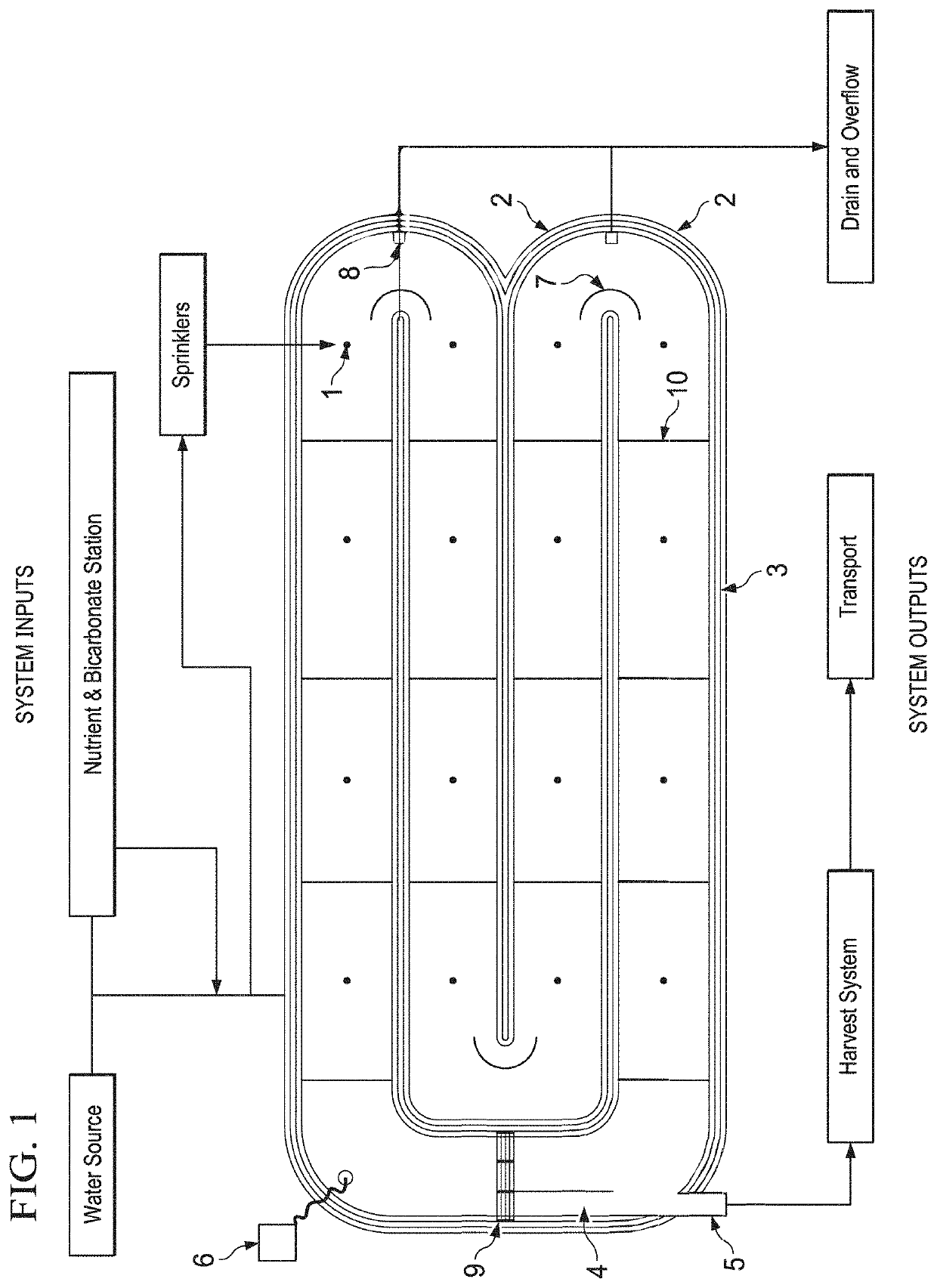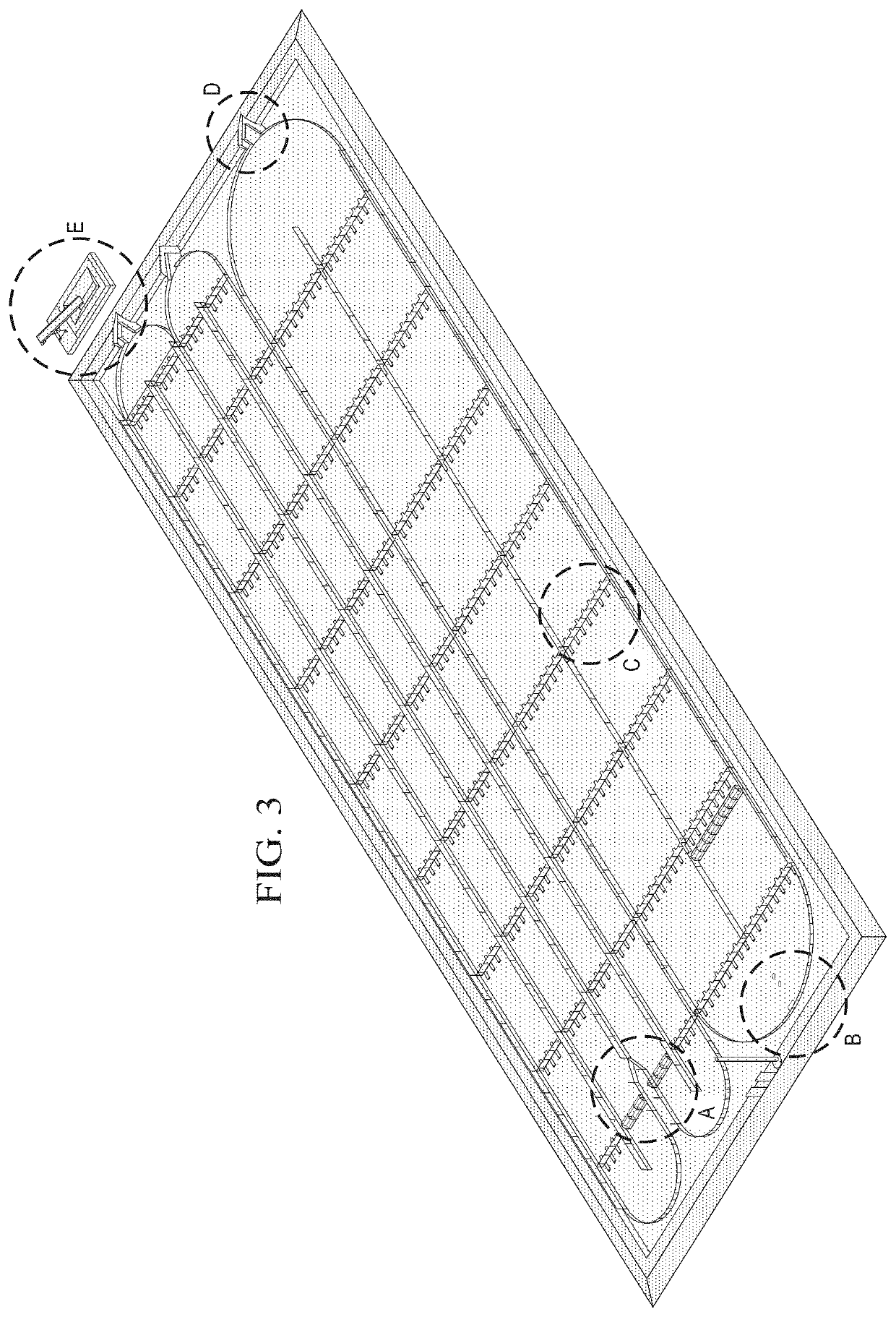Methods of culturing a floating aquatic species using an apparatus for fluid conveyance in a continuous loop
a technology of fluid conveyance and floating aquatic species, which is applied in the fields of horticulture, pisciculture and aquaria, agriculture, etc., can solve the problems that existing fluid conveyance forms may not be suitable for or optimized for controlling
- Summary
- Abstract
- Description
- Claims
- Application Information
AI Technical Summary
Benefits of technology
Problems solved by technology
Method used
Image
Examples
example 1
[0061]FIG. 1 shows an exemplary system for culturing an aquatic species. The system comprises a container defined by a berm 2, on which are mounted windbreaks 3. The container comprises a The system can include a water source which can provide water as the culture medium, a nutrition system (“nutrient and bicarbonate station” in FIG. 1) which can provide at least one nutrient to the system, and a harvest system 5 within a harvest channel 4, in which the aquatic species is harvested. The harvested aquatic species can be transported to a processing center for further processing. A propulsion system 9 is disposed within the container, and floating windbreak 10. The system can also include sprinklers 1 (shown as solid dots) evenly distributed in a 4 by 4 matrix in the system, and a monitoring system 6 for monitoring levels of nutrients, pH, and temperature. Turning vanes 7 are placed within the curved portions of the container. The system can further include a drain and overflow system ...
example 2
[0062]FIG. 2 shows an exemplary static system for culturing an aquatic species. The system can include support augers 11. In the exemplary system, there are thirty-four support augers. Harvest branches 14 are attached to the support auger. In the particular configuration disclosed, there are eleven harvest branches distributed in the system. The mixture of the aquatic species and the culture medium can be harvested through the harvest branches 14 and then supplied to the harvest header 12 in a controlled fashion. Harvest header 12 comprises a 6-inch PVC pipe in this embodiment. After the culture medium is separated from the harvested aquatic species, the culture medium can be delivered back to the system through a return header 17, likewise comprising a 6-inch PVC pipe, and then return branches 13. In the exemplary system, there are seven return branches in the system. The system can include one or more drain sumps 15, 16, 18, 19 for recirculating the culture medium. The dimensions ...
example 3
[0063]In an alternate embodiment of a raceway system, the individual raceways have an elliptical or circular configuration. FIG. 3 illustrates such a configuration, in which three such raceways are placed in a side-by-side configuration. Other embodiments are also contemplated in which a single elliptical raceway is employed, or in which two mirror-image raceways are employed. As can be seen in the figure, this raceway system comprises wind barriers that are situated on the walls or berms making up the raceways, as well as floating wind barriers.
[0064]Particular features of the raceway system of this embodiment, marked with letters A-E in FIG. 3, are depicted in greater detail in FIGS. 4-8. FIG. 4 depicts the paddlewheels and support platforms. The support platforms have a concave top surface matching the curvature of the blades of the paddlewheel to more efficiently develop force. FIG. 5 depicts the drain sumps, which are similar tom those depicted in FIG. 2. FIG. 6 shows the float...
PUM
 Login to View More
Login to View More Abstract
Description
Claims
Application Information
 Login to View More
Login to View More - R&D
- Intellectual Property
- Life Sciences
- Materials
- Tech Scout
- Unparalleled Data Quality
- Higher Quality Content
- 60% Fewer Hallucinations
Browse by: Latest US Patents, China's latest patents, Technical Efficacy Thesaurus, Application Domain, Technology Topic, Popular Technical Reports.
© 2025 PatSnap. All rights reserved.Legal|Privacy policy|Modern Slavery Act Transparency Statement|Sitemap|About US| Contact US: help@patsnap.com



